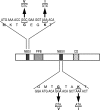Priming of protective anti-Listeria monocytogenes memory CD8+ T cells requires a functional SecA2 secretion system
- PMID: 21402759
- PMCID: PMC3125821
- DOI: 10.1128/IAI.00020-11
Priming of protective anti-Listeria monocytogenes memory CD8+ T cells requires a functional SecA2 secretion system
Abstract
The SecA2 auxiliary secretion system of Gram-positive bacteria promotes the export of virulence proteins essential for colonization of the host in the case of both Mycobacterium tuberculosis and Listeria monocytogenes, two intracellular bacteria causing diseases in humans. We and others have demonstrated that this secretion system is also linked to the onset of long-term CD8(+) T cell-mediated protective immunity in mice. In the case of L. monocytogenes, expression of SecA2 inside the cytosol of infected cells correlates with the generation of CCL3-secreting memory CD8(+) T cells that are required for protection against secondary challenge with wild-type (wt) L. monocytogenes. Since the SecA2 ATPase is well conserved among Gram-positive pathogenic bacteria, we hypothesized that SecA2 itself bears evolutionarily conserved motifs recognized by cytosolic pattern recognition receptors, leading to signaling events promoting the differentiation of CCL3(+) memory CD8(+) T cells. To test this possibility, we generated a stable L. monocytogenes chromosomal mutant that expressed a SecA2 ATPase bearing a mutated nucleotide binding site (NBS). Similarly to a SecA2 deletion mutant, the NBS mutant exhibited rough colonies, a bacterial chaining phenotype, an impaired protein secretion profile, and in vivo virulence in comparison to wt L. monocytogenes. Importantly, mice immunized with the SecA2 NBS mutant were not protected against secondary infection with wt L. monocytogenes and did not develop CCL3(+) memory CD8(+) T cells. NBS mutant and wt SecA2 proteins were expressed to comparable extents by bacteria, suggesting that SecA2 itself is unlikely to promote the induction of these cells. Rather, one or several of the SecA2 substrate proteins released inside the cytosol of infected cells may be involved.
Figures





References
-
- Ahmad-Nejad P., et al. 2002. Bacterial CpG-DNA and lipopolysaccharides activate Toll-like receptors at distinct cellular compartments. Eur. J. Immunol. 32:1958–1968 - PubMed
-
- Archambaud C., Nahori M. A., Pizarro-Cerda J., Cossart P., Dussurget O. 2006. Control of Listeria superoxide dismutase by phosphorylation. J. Biol. Chem. 281:31812–31822 - PubMed
-
- Berche P., Gaillard J. L., Sansonetti P. J. 1987. Intracellular growth of Listeria monocytogenes as a prerequisite for in vivo induction of T cell-mediated immunity. J. Immunol. 138:2266–2271 - PubMed
Publication types
MeSH terms
Substances
LinkOut - more resources
Full Text Sources
Medical
Research Materials
Miscellaneous

